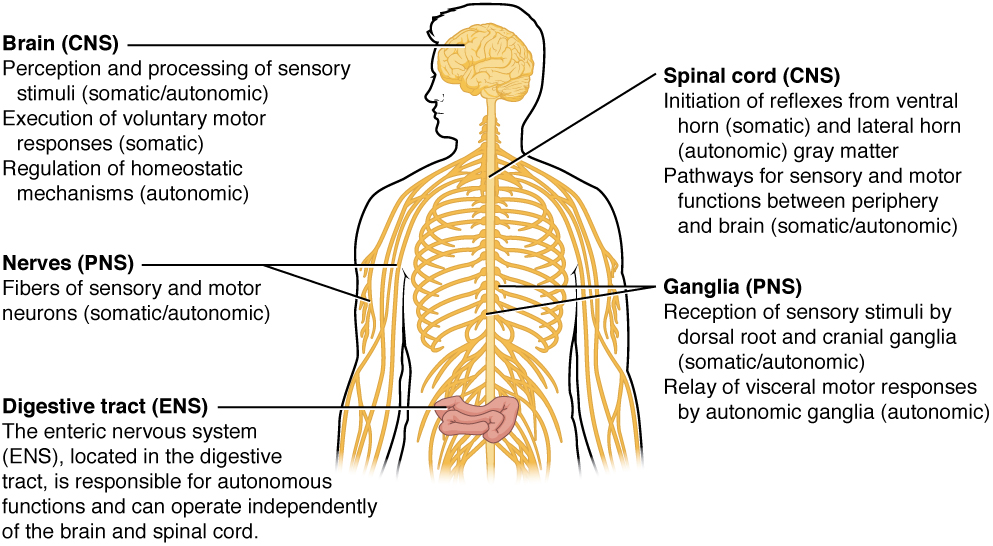©Copyright 2018 GEOSCIENCE RESEARCH INSTITUTE
11060 Campus Street • Loma Linda, California 92350 • 909-558-4548

Have you ever heard someone claim that they are in two minds about something? That usually means they can’t make up their mind about a complex issue; but how many minds can a person really have? Possibly you’re in two–maybe three–minds about that question, but what if we were to ask how many brains a person has? It turns out that it could be more than one!
When we think of our brain, we visualize the amazingly complex organ that sits inside our skull, but there is an intricate system of nerves that serves as the “brain” of our digestive system. This complex of around half a billion nerves regulates things like peristaltic contractions that move digesting food through the system. Think of how complex getting that right actually is. If the food moves too fast, enzymes will not have time to break it down and there will not be enough time to absorb nutrients. At the same time, you don’t want half-digested food sitting around in your bowels for longer than is necessary! Getting the speed of contractions correct requires integrating input from sensors in the gut, correctly deciding what to do, then sending output with the correct instructions to muscles surrounding the different parts of the digestive system.

OpenStax Anatomy and Physiology, available here. File licensed under the Creative Commons Attribution 4.0 International license.
The “abdominal brain”—technically called the “enteric nervous system” or ENS—is involved in far more than just control of peristaltic contractions, it also communicates with the microbiome of the gut, regulates blood flow, synchronizes the excretion of enzymes and interacts with the immune system, and it operates independently of the brain in our head. Recent research conducted by Khomgrit Morarach and colleagues at the Karolinska Institutet in Stockholm, Sweden, has discovered some of the complexity and subtlety of this remarkable system.[1] Using recently developed technology that allows sequencing of all the RNA expressed in individual cells, they were able to identify 12 different subtypes of nerve cells doing different tasks in the abdominal brain, but all working together.
The enteric nervous system exists out of sight, and all its activity happens without us even knowing about it. But just because it is out of mind doesn’t mean that it is dispensable. This remarkable system of nerves appears to be essential for humans and other vertebrates. It illustrates a common phenomenon in biology. Whenever we are tempted to think that something is simple enough that we understand it, it turns out that we have not really thought through all that is essential for the organ or system to work. As Christians, we can be in one mind about our Creator, who did think through every elegant part of us, then created our bodies–and those of every other living thing–fully formed to function and thrive in the world that He created for us. Only He knows what wonders lie still hidden within us and other organisms, wonders that still await our discovery using the brains in our heads!
by Timothy G. Standish, PhD
Geoscience Research Institute
Discussion Questions
- The enteric nervous system is a complex and well-integrated system that performs specific functions. Do you believe it could also represent an example of “irreducible complexity”? Explain why.
- Darwin’s materialistic theory of evolution explains the enteric nervous system as emerging gradually through time, with natural selection preserving successive randomly produced improvements of earlier simpler configurations. What kind of evidence might be collected in support of this scenario?
- Why does the enteric nervous system provide an examples of cooperation between organisms?
- If God endowed humans and other animals with an enteric nervous system from the beginning, does this mean that the system has remained essentially unchanged since creation?
Endnote
[1] Morarach, K., Mikhailova, A., Knoflach, V. et al. Diversification of molecularly defined myenteric neuron classes revealed by single-cell RNA sequencing. Nature Neuroscience (2020). https://doi.org/10.1038/s41593-020-00736-x
See also: https://news.ki.se/new-fundamental-knowledge-of-the-abdominal-brain